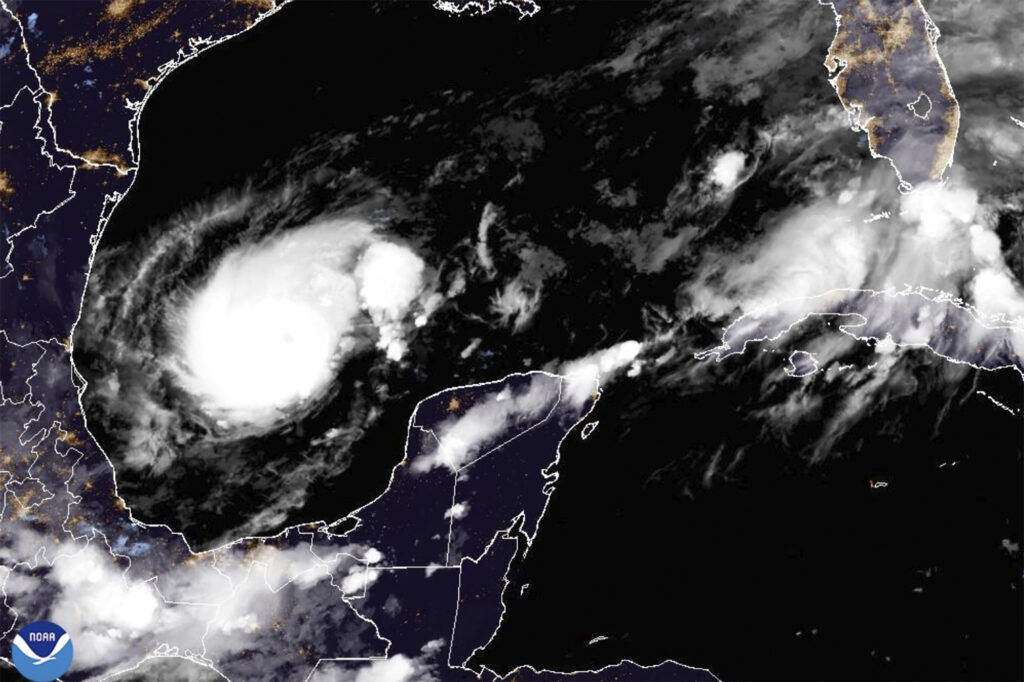Hurricane Milton/ Florida evacuation/ Category 3 hurricane/ Tampa, FEMA/ Hurricane Irma/ Newslooks/ FORT LAUDERDALE/ Florida/ J. Mansour/ Morning Edition/ Hurricane Milton, now a Category 3 storm, heads toward Florida, prompting what could be the state’s largest evacuation since 2017. Authorities are preparing fuel stations, emergency shelters, and National Guard deployments as residents brace for possible landfall near Tampa. FEMA and state agencies are coordinating extensive preparations and aid for affected areas.
Hurricane Milton Forces Evacuations: Quick Looks
- Storm Intensification: Milton reaches Category 3, with 120 mph winds.
- Evacuation Plans: Florida preps for potential largest evacuation since Hurricane Irma.
- Federal Aid: FEMA mobilizes over 137 million dollars in disaster support.
- Gov. DeSantis’ Warning: Residents encouraged to finalize preparations immediately.
- Infrastructure and Support: National Guard and FEMA ready resources for sustained relief.
Florida Braces for Record Evacuations as Hurricane Milton Intensifies
Deep Look
As Hurricane Milton rapidly intensifies into a Category 3 storm, Florida is preparing for what could be its largest evacuation operation in years. The storm, now packing 120 mph winds as it barrels through the southern Gulf of Mexico, has the potential to make landfall near Tampa by Wednesday, posing severe threats to one of Florida’s most densely populated regions.
The National Hurricane Center has issued hurricane warnings for parts of the Mexican coast and watches across Florida’s Gulf Coast. If Milton’s projected path holds, it will cross central Florida and likely re-emerge as a powerful system over the Atlantic. This comes just weeks after Hurricane Helene left a trail of destruction across the southeastern United States, including a death toll that recently climbed to 230, particularly in Florida and surrounding states.
In response to Milton’s rapid intensification, Governor Ron DeSantis expanded Florida’s state of emergency declaration to include 51 counties. State officials have been actively preparing fuel supplies for both gas-powered and electric vehicles along evacuation routes, reinforcing lessons learned from past hurricanes, including Irma in 2017, which saw extensive evacuations and long fuel lines. The Florida Division of Emergency Management has been working around the clock to ensure a streamlined process for residents preparing to evacuate.
Local and Federal Emergency Plans in Motion
DeSantis emphasized that Florida would likely experience significant impacts regardless of Milton’s exact landfall point. He urged residents to use the time before Wednesday to finalize preparations, reminding those on Florida’s west coast and in low-lying areas to anticipate evacuation orders. Florida’s emergency response teams have begun pre-staging resources and are expanding public access to city garages in Tampa and St. Petersburg to help residents protect their vehicles from floodwaters.
Kevin Guthrie, Florida’s emergency management director, stated that the state is fully utilizing shelters and refuge options to manage the anticipated evacuation needs. National Guard personnel, bolstered to 4,000 troops, are deployed throughout the region, prepared to assist in clearing debris and facilitating evacuation logistics. “We are preparing for the largest evacuation we’ve seen since Hurricane Irma,” said Guthrie, adding that some residents in newer, more storm-resistant buildings who are not in designated evacuation zones should consider sheltering in place.
The Pinellas County School District has proactively canceled classes through Wednesday as officials prepare emergency response resources and clear roads for evacuation.
Federal Response and FEMA’s Role
Federal assistance for Florida has already been robust following Hurricane Helene, with the Federal Emergency Management Agency (FEMA) delivering over $137 million in aid to affected areas. With Hurricane Milton now on the approach, FEMA is bolstering its response strategy by coordinating with Florida’s local and state leaders to provide shelter, food, and water resources. FEMA Administrator Deanne Criswell assured Floridians of FEMA’s capability to manage multiple crises, including the continued aid effort for Helene survivors and Milton’s expected impacts.
Despite recent misinformation claims from some political figures, Criswell expressed confidence in FEMA’s work. She reiterated that her team is focused on providing direct, essential support, with more than 14.9 million meals and 3.6 million gallons of water already supplied to storm-hit communities in the Southeast. FEMA, working with the White House and the Department of Defense, has also dispatched over 1,500 active-duty troops, 6,100 National Guard members, and 7,000 federal personnel to the affected areas. This includes an extensive mobilization of resources such as generators, medical aid, and funds for temporary housing, allowing residents a refuge while rebuilding.
President Joe Biden has affirmed FEMA’s extensive involvement in providing aid to those impacted by recent storms. “We are committed to supporting every family affected, and we’ll keep working alongside state and local leaders, no matter how long it takes,” Biden said, highlighting FEMA’s capacity to manage concurrent disasters.
Historical Context and Preparation Lessons
The threat of Hurricane Milton has triggered Florida’s largest evacuation plans since Hurricane Irma in 2017, when about seven million people were urged to leave their homes. Irma caused massive disruption, including hours-long lines at gas stations and heavy congestion on evacuation routes, and left many evacuees frustrated. Building on Irma’s challenges, Florida has established contingency fuel reserves and charging stations for electric vehicles along primary evacuation routes.
Public officials are particularly concerned about Tampa Bay and the St. Petersburg area, still reeling from Hurricane Helene’s devastation, which resulted in significant flooding and infrastructure damage along the coastal areas. The storm surge from Helene, which ravaged a 20-mile stretch of barrier islands, caused widespread damage, leaving the local community on high alert as Milton approaches.
Future Steps and Regional Risks
The potential impact of Hurricane Milton goes beyond immediate landfall. If it crosses central Florida as predicted, the storm could bring high winds and flooding to inland communities before re-strengthening over the Atlantic. This trajectory has the potential to affect coastal areas in Georgia and the Carolinas, adding further strain to a region still in recovery from Helene.
Federal and state agencies, however, are determined to ensure resources are available to those impacted by either storm. FEMA’s operations across the Southeast are expected to continue uninterrupted, with active-duty personnel ready to deploy to any new areas Milton may affect.







